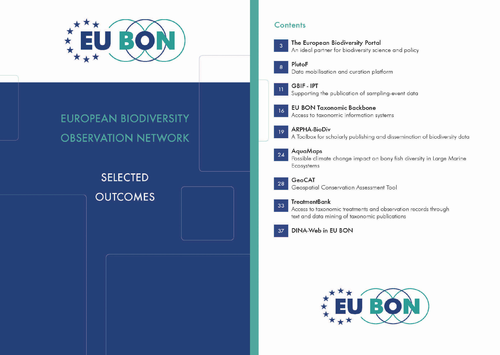A recent story, featured on CORDIS News, focuses on EU BON and its achievements. Based on a recent project's publication in ‘Nature – Scientific Reports’ and information from the project, the new item discusses important project outcomes, including the European Biodiversity Portal, and their contribution to drawing a more accurate picture of current biodiversity to aid efforts for sustainable governance of natural resources.
Here is a snippet from the news feature on CORDIS:
A recent article published in the journal ‘Scientific Reports’ states, ‘Monitoring schemes provide an important source of information on biodiversity change, guiding further research, conservation assessment and planning.’ The article cites The European Biodiversity Portal, designed and implemented by the EU-funded EU BON project that offers researchers, policy-makers, and others interested in biodiversity, easy access to insights on trends and modelling techniques.
The project worked on the establishment and adoption of new data standards, the development of tools to enable collaborative research and the encouragement of citizen-scientists. As a result, EU BON, by building the European Biodiversity Observation Network, has created advanced techniques for data analysis along with new approaches for modelling and strategies for future biodiversity monitoring.
Read the full publication here.
Taking place from 14 to 16 March 2017, the Final EU BON Meeting served as a platform to present key outputs from the FP7 EU-funded project EU BON " Building the European Biodiversity Observation Network" which aims to advance biodiversity knowledge by building a European gateway for biodiversity information and by integrating and harmonising a wide range of biodiversity data.
Hosted by the Royal Belgian Institute of Natural Sciences in Brussels and at the stunning backdrop of Botanic Garden in Meise, EU BON partners met with stakeholders from research, European policy and citizen science to learn about the project's results and outputs and to discuss the future of a European Biodiversity Observation Network.
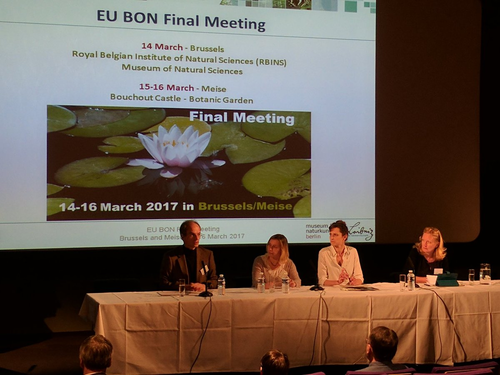
Credit: Donat Agosti
EU BON represents a joint effort of 31 partners from 15 European countries, Israel, the Philippines, Brazil and more than 30 associated partners. The project worked on the establishment and adoption of new data standards, the development of tools, the integration of advanced techniques for data analysis and the development of new approaches and strategies for future biodiversity monitoring and assessment.
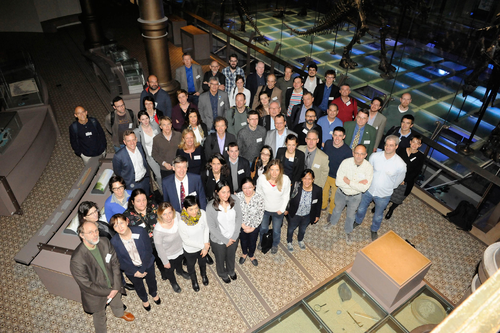
Group Photo; Credit: D. Schmeller
At the Final Meeting participants had the opportunity to learn about and test products and services developed by project members during the period 2012-2017. These include a range of tools for data analysis, such as GeoCAT -- a tool that performs rapid geospatial analysis to ease the process of Red Listing taxa and AquaMaps -- a toolkit that models the distribution and makes predictions of where aquatic species occur naturally. Another group of tools -- the GBIF Integrated Toolkit and ARPHA-BioDiv facilitates the process of data sharing, integration and publishing.
Among the services presented, worthy of special mention is the EU BON Unified Taxonomic Information Service (UTIS) that allows the running of a federated search on multiple European taxonomic checklists by scientific name or vernacular name strings. These include the Pan-European Species directories Infrastructure (EU-Nomen), the European Nature Information System (EUNIS), the Catalogue of Life, the World Register of Marine Species (WoRMS), the GBIF Checklist Bank and the Plazi Treatment Bank.
All these web applications are bound together under the umbrella of the EU BON European Biodiversity Portal, with highly relevant contributions to the aims of the Group on Earth Observation's Biodiversity Observation Network (GEO BON). Besides applied tools and software, the portal also serves as an online library for manuals, guidelines, factsheets, case studies, policy recommendations and other documents.
Learn more about these tools in our Final Brochure.
For live updates, follow EU BON on Twitter, or like us on Facebook. See the live Tweet feed from the meeting at #eubongm.
The discipline of taxonomy is highly reliant on previously published photographs, drawings and other images as biodiversity data. Inspired by the uncertainty among taxonomists, a team, representing both taxonomists and experts in rights and copyright law, has traced the role and relevance of copyright when it comes to images with scientific value. Their discussion and conclusions are published in the latest paper added in the EU BON Collection in the open science journal Research Ideas and Outcomes (RIO).
Taxonomic papers, by definition, cite a large number of previous publications, for instance, when comparing a new species to closely related ones that have already been described. Often it is necessary to use images to demonstrate characteristic traits and morphological differences or similarities. In this role, the images are best seen as biodiversity data rather than artwork. According to the authors, this puts them outside the scope, purposes and principles of Copyright. Moreover, such images are most useful when they are presented in a standardized fashion, and lack the artistic creativity that would otherwise make them 'copyrightable works'.
"It follows that most images found in taxonomic literature can be re-used for research or many other purposes without seeking permission, regardless of any copyright declaration," says Prof. David J. Patterson, affiliated with both Plazi and the University of Sydney.
Nonetheless, the authors point out that, "in observance of ethical and scholarly standards, re-users are expected to cite the author and original source of any image that they use." Such practice is "demanded by the conventions of scholarship, not by legal obligation," they add.
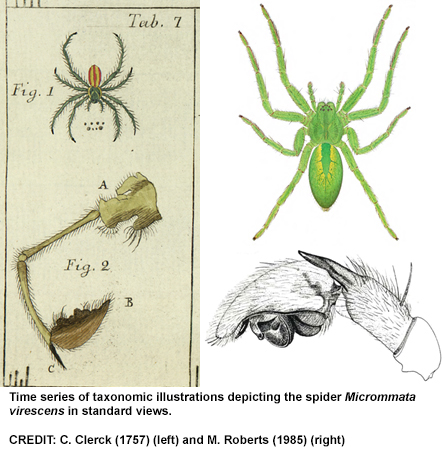 However, the authors underline that there are actual copyrightable visuals, which might also make their way to a scientific paper. These include wildlife photographs, drawings and artwork produced in a distinctive individual form and intended for other than comparative purposes, as well as collections of images, qualifiable as databases in the sense of the European Protection of Databases directive.
However, the authors underline that there are actual copyrightable visuals, which might also make their way to a scientific paper. These include wildlife photographs, drawings and artwork produced in a distinctive individual form and intended for other than comparative purposes, as well as collections of images, qualifiable as databases in the sense of the European Protection of Databases directive.
In their paper, the scientists also provide an updated version of the Blue List, originally compiled in 2014 and comprising the copyright exemptions applicable to taxonomic works. In their Extended Blue List, the authors expand the list to include five extra items relating specifically to images.
"Egloff, Agosti, et al. make the compelling argument that taxonomic images, as highly standardized 'references for identification of known biodiversity,' by necessity, lack sufficient creativity to qualify for copyright. Their contention that 'parameters of lighting, optical and specimen orientation' in biological imaging must be consistent for comparative purposes underscores the relevance of the merger doctrine for photographic works created specifically as scientific data," comments on the publication Ms. Gail Clement, Head of Research Services at the Caltech Library.
"In these cases, the idea and expression are the same and the creator exercises no discretion in complying with an established convention. This paper is an important contribution to the literature on property interests in scientific research data - an essential framing question for legal interoperability of research data," she adds.
###
Original source:
Egloff W, Agosti D, Kishor P, Patterson D, Miller J (2017) Copyright and the Use of Images as Biodiversity Data. Research Ideas and Outcomes 3: e12502. https:/
Europe’s regions are facing rising sea levels and more extreme weather, such as more frequent and more intense heatwaves, flooding, droughts and storms due to climate change, according to the latest European Environment Agency report published on 25 Jan 2017. The report assesses the latest trends and projections on climate change and its impacts across Europe and finds that better and more flexible adaptation strategies, policies and measures will be crucial to lessen these impacts.
Find a summary of the report's Key Findings, or download the full report.
While development and implementation of data publishing and sharing practices and tools have long been among the core activities of the academic publisher Pensoft, it is well-understood that as part of scholarly publishing, open data practices are also currently in transition, and hence, require a lot of collaborative and consistent efforts to establish.
Based on Pensoft's experience, and elaborated and updated during the Framework Program 7 EU BON project, a new paper published in the EU BON dedicated collection in the open science journal Research Ideas and Outcomes (RIO), outlines policies and guidelines for scholarly publishing of biodiversity and biodiversity-related data. Newly accumulated knowledge from large-scale international efforts, such as FORCE11 (Future of Research Communication and e-Scholarship), CODATA (The Committee on Data for Science and Technology), RDA (Research Data Alliance) and others, is also included in the Guidelines.
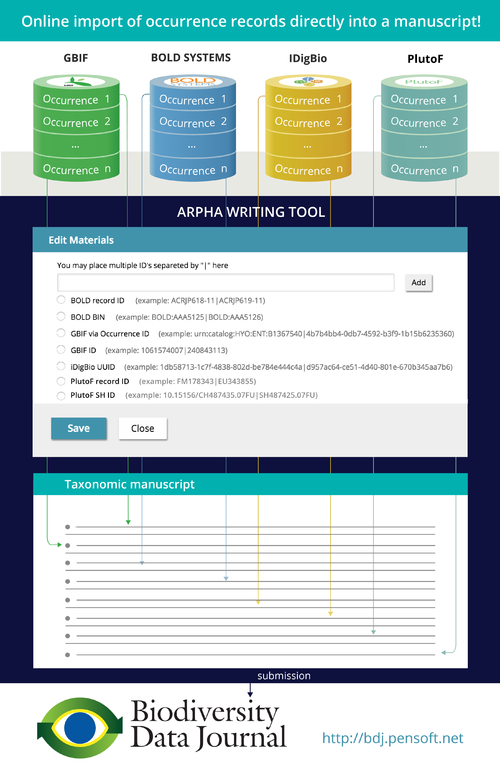 The present paper discusses some general concepts, including a definition of datasets, incentives to publish data and licences for data publishing. Furthermore, it defines and compares several routes for data publishing, namely: providing supplementary files to research articles; uploading them on specialised open data repositories, where they are linked to the research article; publishing standalone data papers; or making use of integrated narrative and data publishing through online import/download of data into/from manuscripts, such as the workflow provided by the Biodiversity Data Journal. Among the guidelines, there are also comprehensive instructions on preparation and peer review of data intended for publication.
The present paper discusses some general concepts, including a definition of datasets, incentives to publish data and licences for data publishing. Furthermore, it defines and compares several routes for data publishing, namely: providing supplementary files to research articles; uploading them on specialised open data repositories, where they are linked to the research article; publishing standalone data papers; or making use of integrated narrative and data publishing through online import/download of data into/from manuscripts, such as the workflow provided by the Biodiversity Data Journal. Among the guidelines, there are also comprehensive instructions on preparation and peer review of data intended for publication.
Although currently available for journals using the developed by Pensoft journal publishing platform ARPHA, these strategies and guidelines could be of use for anyone interested in biodiversity data publishing.
Apart from paving the way for a whole new approach in data publishing, the present paper is also a fine example of science done in the open, having been published along with its two pre-submission public peer reviews. The reviews by Drs. Robert Mesibov and Florian Wetzel are both citable via their own Digital Object Identifiers (DOIs).
###
Original source:
Penev L, Mietchen D, Chavan V, Hagedorn G, Smith V, Shotton D, Ó Tuama É, Senderov V, Georgiev T, Stoev P, Groom Q, Remsen D, Edmunds S (2017) Strategies and guidelines for scholarly publishing of biodiversity data. Research Ideas and Outcomes 3: e12431. https:/
Published just recently, a new open access EU BON article discusses the need for additional research efforts beyond standard biodiversity monitoring to reconstruct the impacts of major anthropogenic pressures and to identify meaningful temporal baselines for biodiversity.
The article, published in Scientific Reports, reports on the temporal baselines that could be drawn from biodiversity monitoring schemes in Europe and compares those with the rise of important anthropogenic pressures.
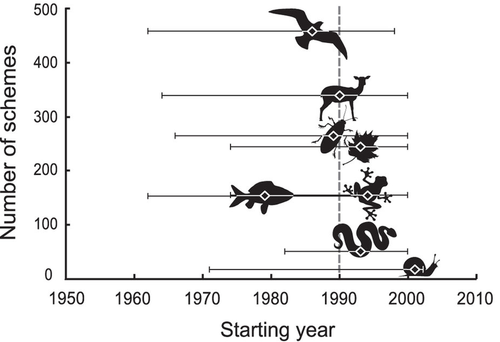
With most biodiversity monitoring schemes initiated late in the 20th century, well after anthropogenic pressures had already reached half of their current magnitude, the team of scientists found that setting temporal baselines from biodiversity monitoring data would underestimate the full range of impacts of major anthropogenic pressures.
The authors stress that these limitations need to be explicitly acknowledged when designing management strategies and policies as they seriously constrain our ability to identify relevant conservation targets aimed at restoring or reversing biodiversity losses.
Find out more in the original research paper:
Mihoub J B, Henle K, Titeux N, Brotons L, Brummitt N A, Schmeller D S (2017) Setting temporal baselines for biodiversity: the limits of available monitoring data for capturing the full impact of anthropogenic pressures. Scientific Reports. http://dx.doi.org/10.1038/srep41591
The Final EU BON Meeting is scheduled to take place from 14-16 March 2017 at the Royal Belgian Institute of Natural Sciences in Brussels and at the stunning backdrop of Botanic Garden in Meise.
EU BON invites all interested parties to mark the dates in their diaries and come to learn about the project’s results and outputs some of which are presented in this newsletter and some are yet to come.
More information is available on the Conference website: http://symposium.eubon.eu

A new report has been added to the dedicated EU BON Outputs Collection in the innovative RIO journal. The paper reviews biodiversity related citizen science in Europe, specifically the data mobilization aspect and gives an overview of citizen science related activities in the project EU BON.
In addition, recommendations for a Pan-European citizen science gateway and data mobilization efforts will be given, with the aim of filling in existing biodiversity data gaps. Also the EU BON citizen science gateway is described, which is a part of the European Biodiversity Portal (http://biodiversity.eubon.eu) with citizen science related products.
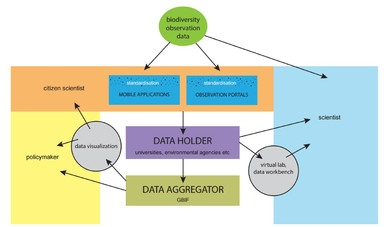
Citizen science is a vital element for EU BON with regards to biodiversity information sources that provide data for research and policy-making. CS data are used by many research institutes, public organisations and local data portals. CS data offer volumes of field data, which would otherwise not be possible to collect with the limited resources of research institutes and agencies. Thus one of the main targets for EU BON is to make CS data available through various efforts, for example through networking and by using new technologies for data mobilisation. Overall, one of the main goals of a common EU citizen science Gateway is to integrate CS data for European biodiversity research. EU BON also seeks to develop a strategy for achieving this goal and encourages educational aspects of citizen science through networking and the development of tools.
Original Source:
Runnel V, Wetzel F, Groom Q, Koch W, Pe’er I, Valland N, Panteri E, Kõljalg U (2016) Summary report and strategy recommendations for EU citizen science gateway for biodiversity data. Research Ideas and Outcomes 2: e11563. https://doi.org/10.3897/rio.2.e11563
The 4th EU BON roundtable took place on 17 November 2016 in the Museum für Naturkunde in Berlin. Focused on the topic "Pathways to sustainability for EU BONs network of collaborators and technical infrastructure" the 35 participants discussed key questions with regards to the sustainability of the EU BON network and products, and shared their rich expertise, coming from different backgrounds ranging from science to policy.
The Roundtable brought together key European users and stakeholders, such as the European Environment Agency, UNEP GRID, and the GEO secretariat, including 27 different institutions and organisations, as well as European funded projects, infrastructures and networks that share the EU BON objectives of assembling biodiversity and ecosystem-related data and knowledge, such as Lifewatch, the European Citizen Science Association (ECSA), ECOPOTENTIAL, EKLIPSE and others.
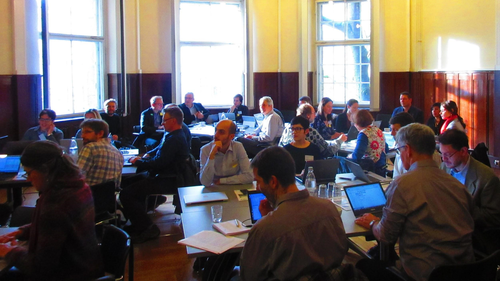
Credit: Florian Wetzel
In her welcome address, Katrin Vohland, head of the Science Programme "Public Engagement with Science" and task lead for stakeholder engagement in EU BON explained that key lessons learnt are that:
-
stakeholder identification may yield unexpected results as in the case of EU BON where next to scientifically based organisation less practitioners but more citizen scientists seem to become stakeholder;
-
early and continuous connections are necessary, as for example to other EU initiatives and projects;
-
target group specific communication avoiding acronyms helps; and
-
the idea of teal organisations may support overcoming the limitations to make networks economically sustainable - which are important but non-monetary assets.
While former Roundtables addressed European policy, citizen science and the link to practitioners, this final EU BON Stakeholder event discussed the future and sustainability of the European biodiversity observation network and its products and tools.
Key questions for the participants were:
-
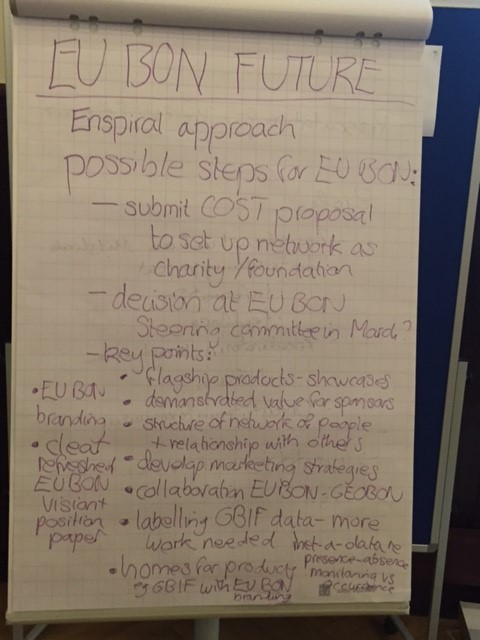
How can the many different EU BON products be sustained and further developed after the project ends in May 2017?
-
Which institutions will host the products in the future and what key products could be further developed by EU BON to meet European and global policy and research needs (e.g. for monitoring, reporting)?
-
How can a European Biodiversity Network as a whole be sustained in order to serve as a central infrastructure and pool of expertise for generating biodiversity data and information on a European scale?
Ideas and plans were developed to secure the sustainability and long term re-use of EU BON products. More information on the outcomes of the meeting can be found below in the minutes and the presentations given during the day.
The report form the meeting was officially published in RIO Journal as a part of the dedicated EU BON outputs collection:
Wetzel F, Despot Belmonte K, Bingham H, Underwood E, Hoffmann A, Häuser C, Mikolajczyk P, Vohland K (2017) 4th European Biodiversity Observation Network (EU BON) Stakeholder Roundtable: Pathways to sustainability for EU BONs network of collaborators and technical infrastructure. Research Ideas and Outcomes 3: e11875. https://doi.org/10.3897/rio.3.e11875
For further information please contact:
Dr. Katrin Vohland, Museum für Naturkunde Berlin, Email: katrin.vohland@mfn-berlin.de
Dr. Florian Wetzel, Museum für Naturkunde Berlin, Email: florian.wetzel@mfn-berlin.de
Presentations from the meeting:
2. Key achievements _ Christoph Häuser
3.1 EUBON Products_ Lauren Weatherdon
3.2 EU BON products and stakeholders_David Rose
4. EU BON and modelling tools_Bill Kunin
5. CS and EU BON tools_Bernat Claramunt
6. Businessplan_Sustainability_Dirk Schmeller
7 .EKLIPSE_EUBON_Carsten Nesshöfer-Dirk Schmeller
8. EEA - EEA_EU BON_Beate Werner
9. LifeWatch_Wouter Los_Christos Arvanitidis
10. Thoughts on Sustainability_Gary Geller
11. Biodiversity data, gaps and effors_Florian_Wetzel
12. EUBON-portal_Tim Robertson
Recently published the GEO Handbook on Biodiversity Observation Networks presents a powerful resource that will provide valuable guidance to those committed to protecting, sustaining and preserving biodiversity across the planet. The practical experience which GEO BON has accumulated through its own actions, and through the efforts of its network partners, is a valuable resource to biodiversity information systems everywhere—from those just starting out in places where there has previously been little information, to large operations holding vii enormous amounts of data and wishing to know how better to use it.
The Group on Earth Observations (GEO) is a voluntary international partnership of 102 governments and 92 participating organisations which share a vision of a future in which decisions and actions for the benefit of humankind are informed by coordinated, comprehensive and sustained Earth observations. GEO achieves its mission largely through self-organising communities focused on important Earth observation domains where decision-making will benefit from data that is shared broadly and openly. These communities form connected systems and networks, creating a Global Earth Observation System of Systems (GEOSS).
During its first ten-year implementation period, 2005–2015, GEO identified biodiversity as a key ‘Societal Benefit Area’, resulting in the formation of the GEO Biodiversity Observation Network, GEO BON. As GEO moves into its second, ten-year implementation period, GEO BON is recognised as one of its strongest communities. It has helped to mobilise and coordinate the data and information needed for an effective response to the global threats faced by organisms, species and ecosystems. In collaboration with international treaty bodies such as the Convention on Biological Diversity (CBD) and the Ramsar Convention on Wetlands of International Importance, GEO BON has worked with national conservation agencies and non-governmental organisations at scales from regional to global. These efforts have revealed both the benefits of working together and the challenges of such a complex, but urgent task, not least of which is filling the remaining large gaps in data and information.




 RSS news
RSS news
